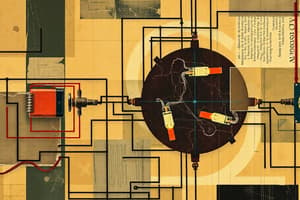Podcast
Questions and Answers
In a parallel circuit, how are components connected?
In a parallel circuit, how are components connected?
- Side-by-side creating separate paths for current flow (correct)
- End-to-end along a single pathway
- Diagonally across each other
- In a loop configuration
What is the primary advantage of parallel circuits over series circuits?
What is the primary advantage of parallel circuits over series circuits?
- Reduced resistance and increased total current flow capacity (correct)
- Higher resistance
- Lower current flow capacity
- Fewer pathways for current flow
Why can parallel circuits be an ideal choice for high-current applications?
Why can parallel circuits be an ideal choice for high-current applications?
- Their complexity in connecting components together
- Because they offer fewer pathways for current flow
- Their ability to reduce resistance and increase total current flow capacity (correct)
- Due to their higher resistance
What is a significant disadvantage of parallel circuits compared to series circuits?
What is a significant disadvantage of parallel circuits compared to series circuits?
Which law do parallel circuits follow, unlike series circuits?
Which law do parallel circuits follow, unlike series circuits?
What is a characteristic of series circuits?
What is a characteristic of series circuits?
Which type of circuit is primarily used for phase shifting and voltage control purposes?
Which type of circuit is primarily used for phase shifting and voltage control purposes?
What do L-Series circuits consist of?
What do L-Series circuits consist of?
How do C-series circuits affect the overall impedance of a circuit?
How do C-series circuits affect the overall impedance of a circuit?
In which type of circuit do capacitive reactances combine with resistances to create an additional reactive term?
In which type of circuit do capacitive reactances combine with resistances to create an additional reactive term?
What purpose do R-series circuits primarily serve?
What purpose do R-series circuits primarily serve?
Flashcards are hidden until you start studying
Study Notes
Series Circuits
Series circuits are combinations of components where each component is connected sequentially to form a single pathway through which current flows. Each component in a series circuit is connected directly to the voltage source. There are three fundamental types of series circuits: "R-series," "L-series," and "C-series."
R-Series Circuits
An "R-series" circuit contains only resistors, making them commonly used in everyday applications. When applied directly to a power supply, these resistors prevent damage to other electronic devices connected downstream in the circuit. They also adjust the operating voltage levels within electronic systems, allowing further distribution across network connections.
L-Series Circuits
"L-series" circuits consist of capacitors and inductors connected between the power supply and load. These components alter the flow of energy through the circuit, affecting its frequency response and impedance characteristics. As a result, L-series circuits are essential in filtering high-frequency noise and signal processing tasks.
C-Series Circuits
"C-series" circuits involve capacitors connected between the load and ground. Capacitive reactances of parallel circuits combine with the resistance of the series circuit components to create an additional complex reactive term called Xc, which affects the overall impedance of the circuit. C-series circuits are primarily used for phase shifting and voltage control purposes.
Parallel Circuits
Parallel circuits differ from series circuits in their connection structure. Unlike series circuits, where components are arranged so that each produces its effect in turn along a single pathway, parallel circuits connect components side-by-side, forming separate paths for current flow. Each branch can be considered a separate independent circuit, allowing multiple components to operate simultaneously without affecting each other.
Advantages of Parallel Circuits
The primary advantage of parallel circuits is their ability to reduce resistance, thereby increasing the total current flow capacity of the circuit. This makes parallel circuits an ideal choice for high-current applications, such as power distribution systems. In addition, the failure of one component in a parallel circuit does not affect the others, ensuring continued operation of the overall system.
Disadvantages of Parallel Circuits
One of the main disadvantages of parallel circuits is the complexity associated with connecting multiple components together. This can lead to errors during assembly or maintenance operations. Additionally, balancing the current distribution among all branches can also pose challenges, especially when the load values vary significantly across different channels.
Differences Between Series and Parallel Circuits
Series and parallel circuits have several key differences in terms of component connection patterns, current flow, and overall performance characteristics. Some notable differences include:
- Component Connection Patterns: Series circuits connect components end-to-end along a single pathway, while parallel circuits connect components side-by-side, creating multiple paths for current flow.
- Current Flow: Series circuits have a fixed total resistance value determined by the values of all components combined. In contrast, parallel circuits offer lower resistance compared to series circuits, resulting in increased current flow capacity.
- Resistance: Series circuits experience higher resistance due to having fewer conductors, leading to greater power loss in the form of heat dissipation. Parallel circuits reduce resistance, improving efficiency and reducing power losses.
- Operating Principles: Series circuits follow Ohm's Law, where the total resistance equates to the sum of individual resistances. Conversely, parallel circuits follow Kirchhoff's Laws, which state that the total resistance equals the reciprocal of the sum of the inverse individual resistances.
- Simplicity vs Complexity: Series circuits are simpler to construct and maintain since there is only one pathway for current flow. However, parallel circuits are more complex due to their multi-path nature.
In summary, series and parallel circuits serve distinct roles in electrical engineering, offering advantages suited for specific applications based on their unique characteristics. Understanding these fundamentals enables effective design and analysis of electrical systems, ensuring optimal performance and reliability.
Studying That Suits You
Use AI to generate personalized quizzes and flashcards to suit your learning preferences.




